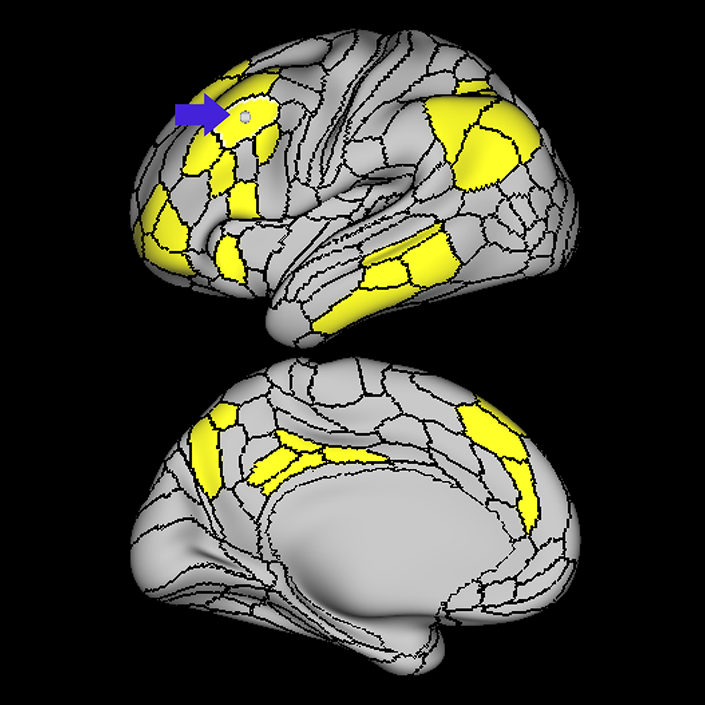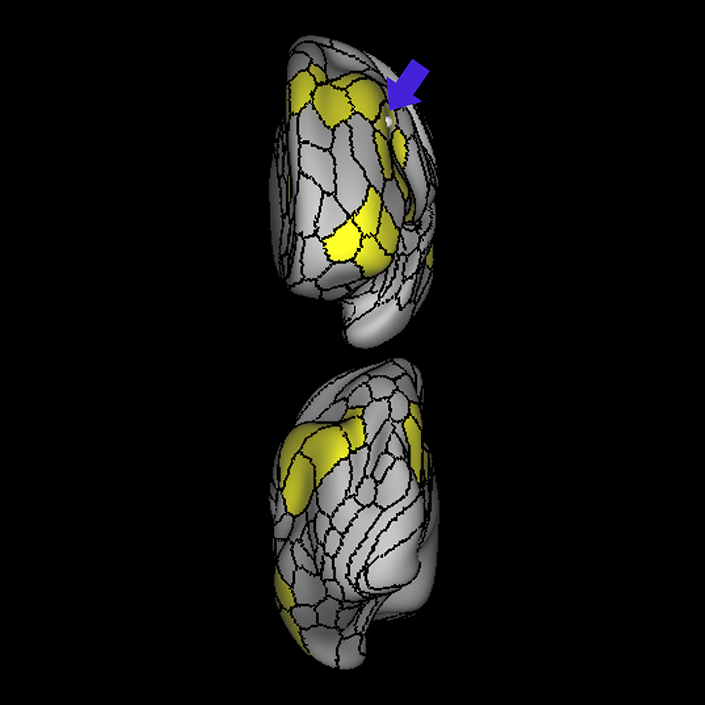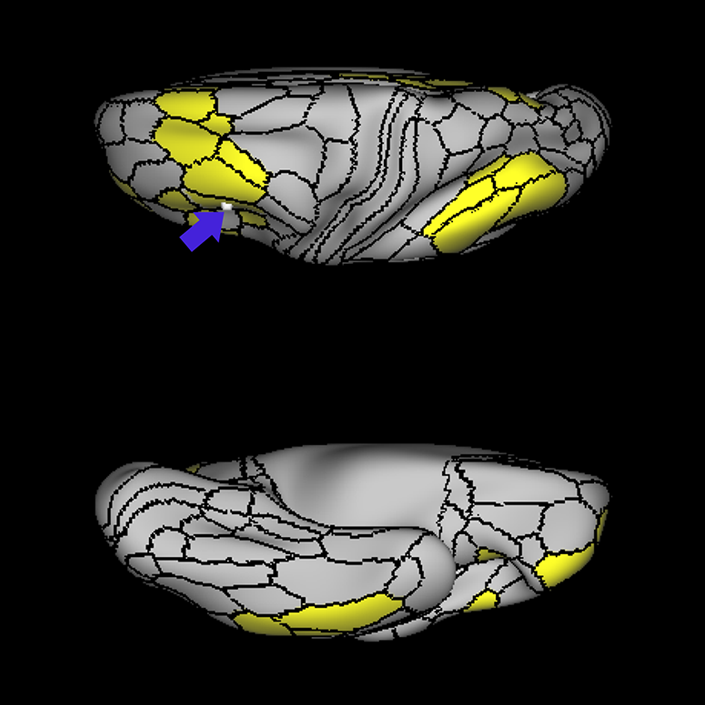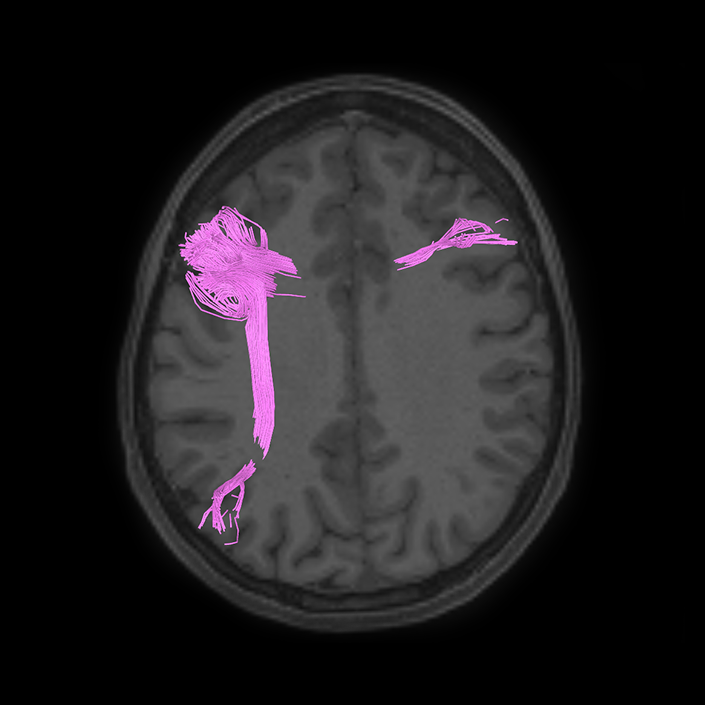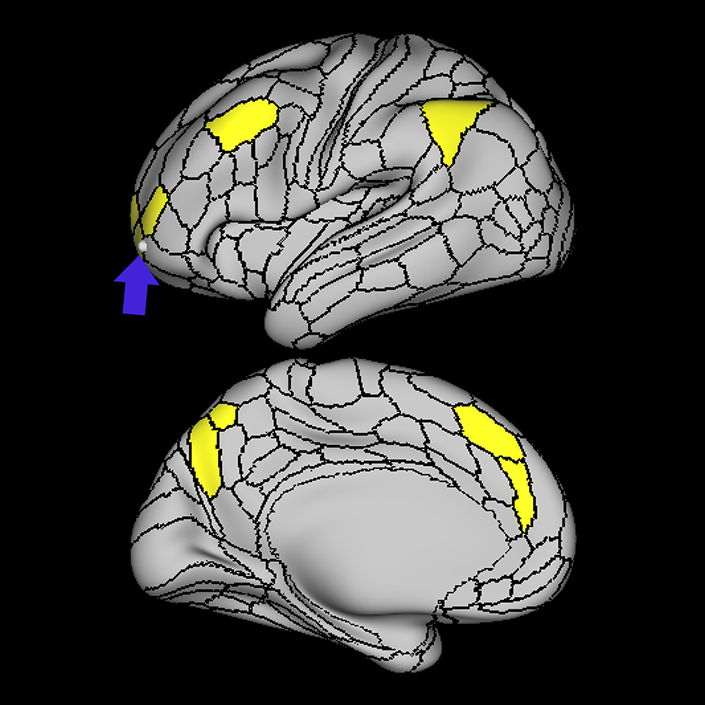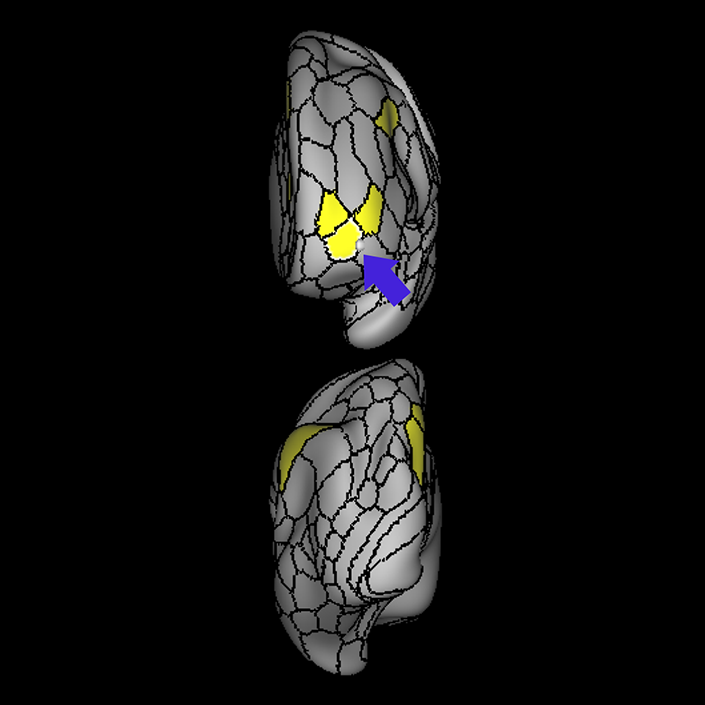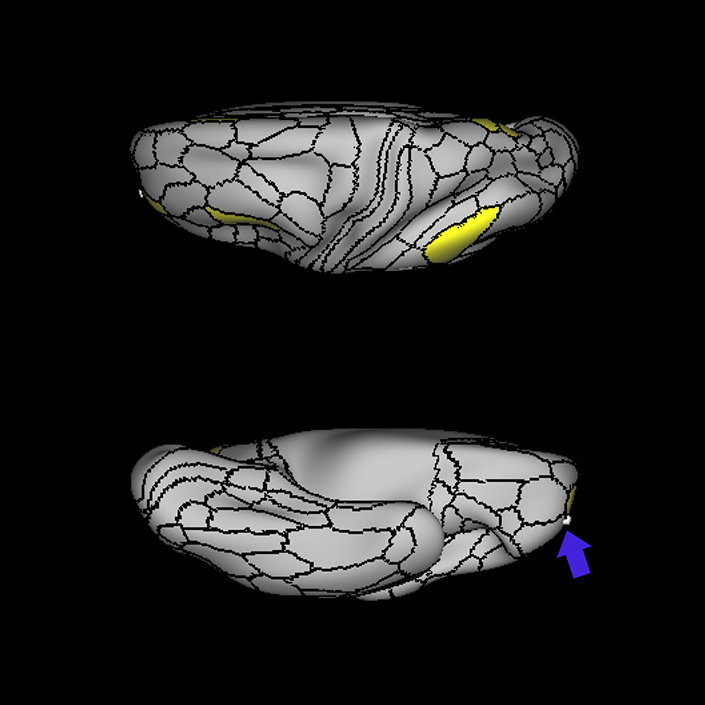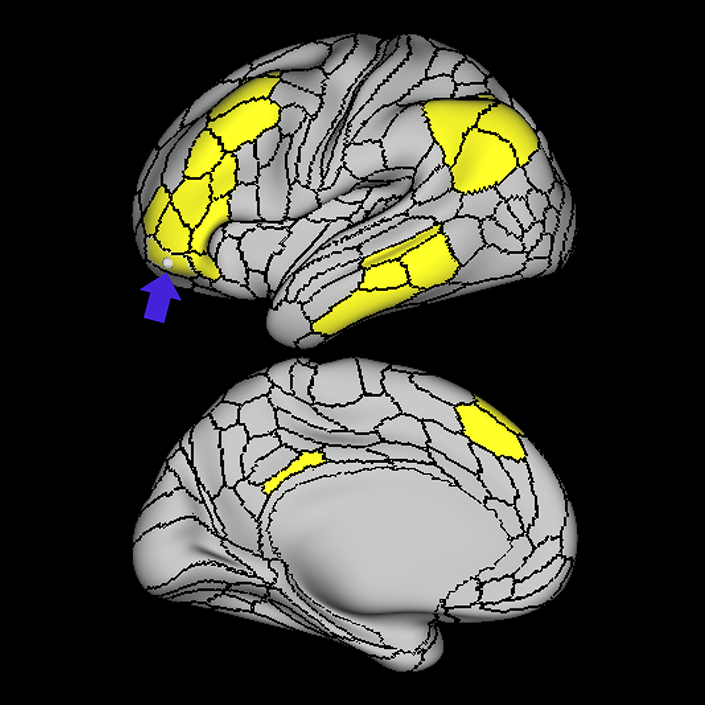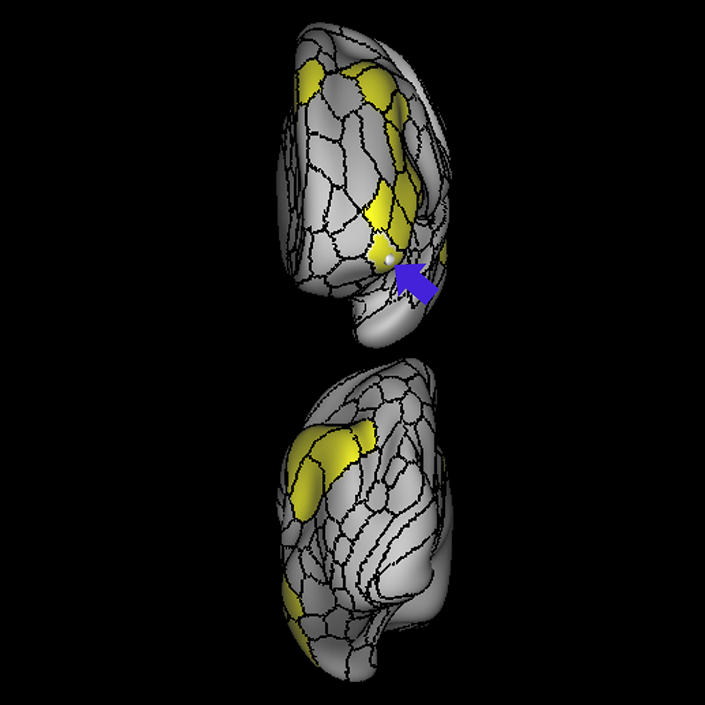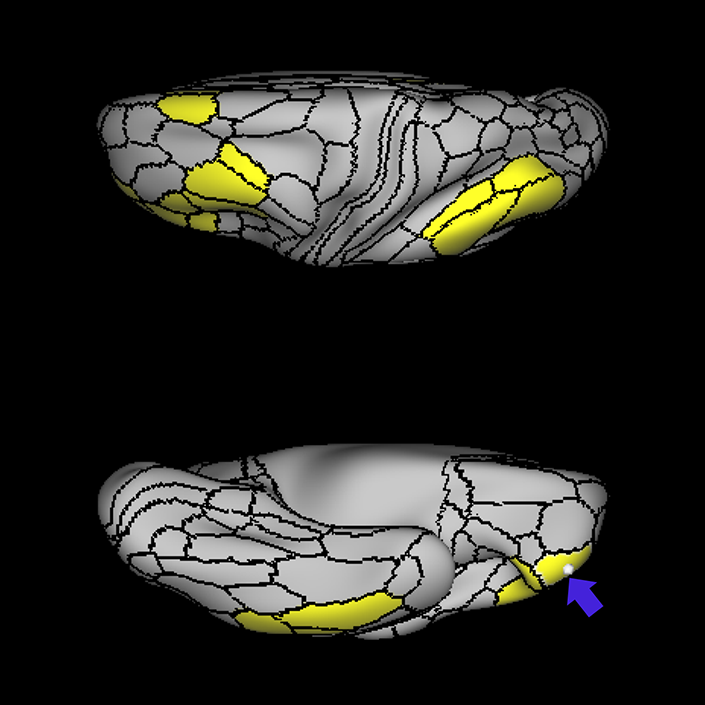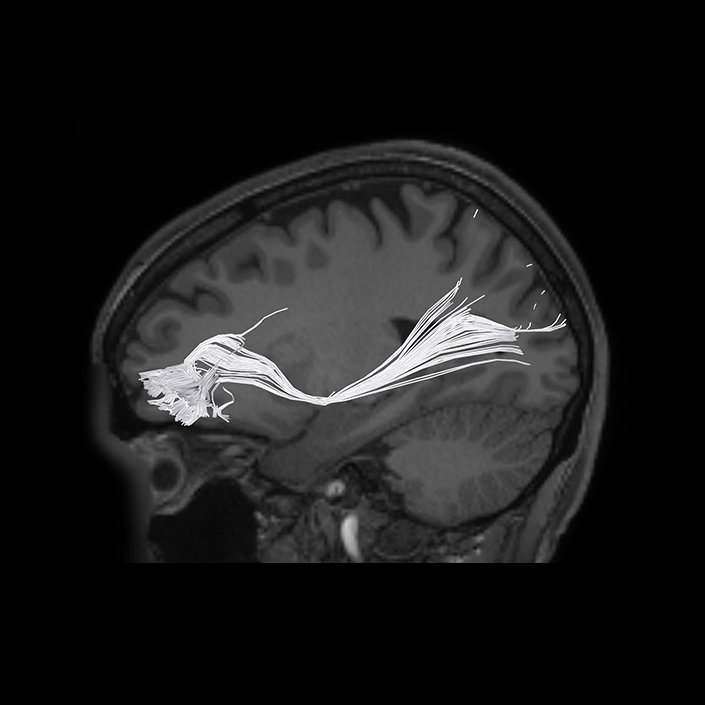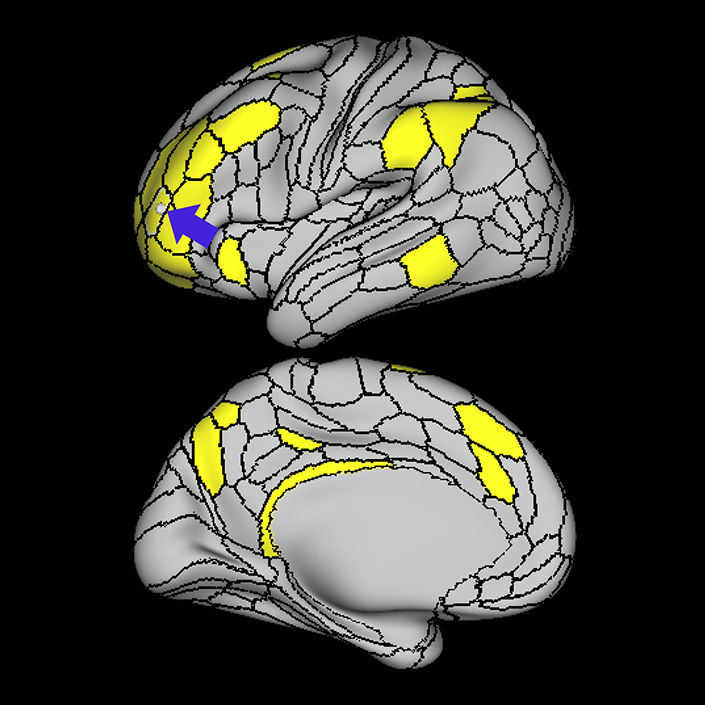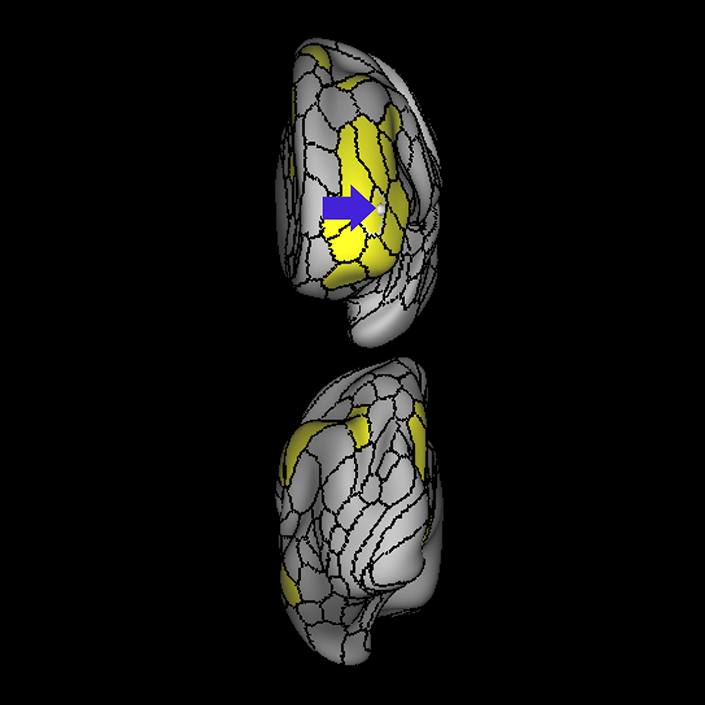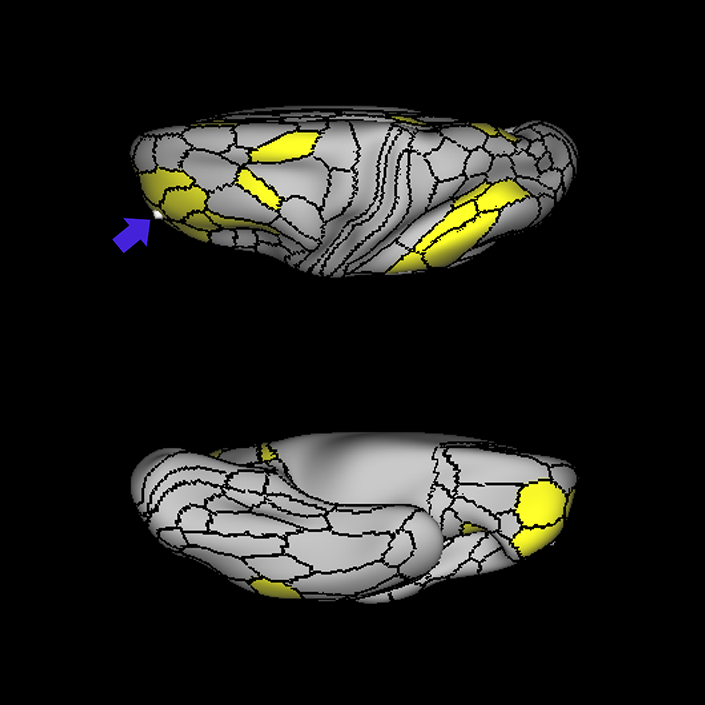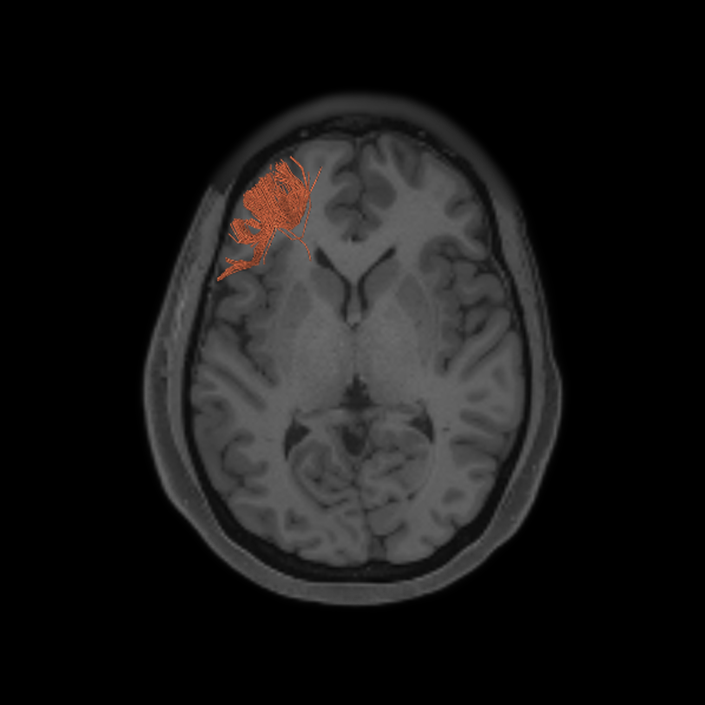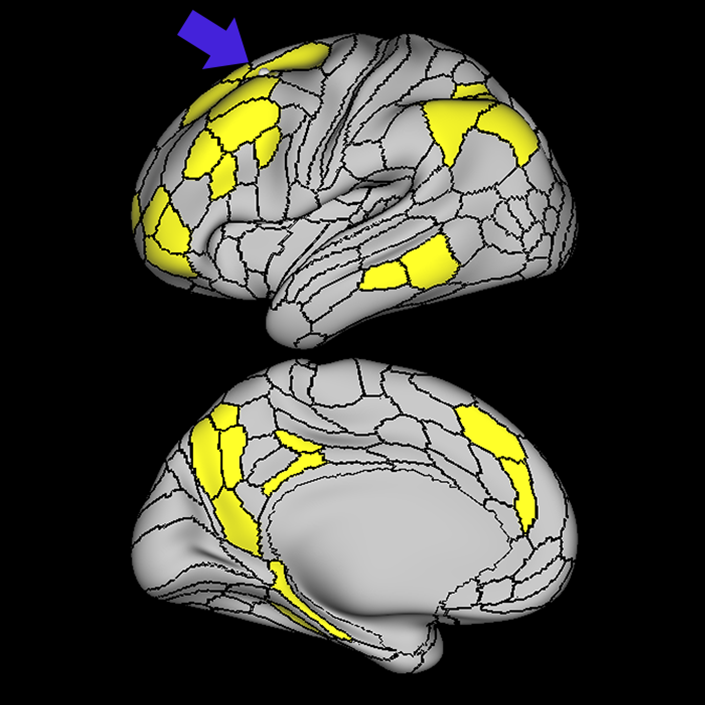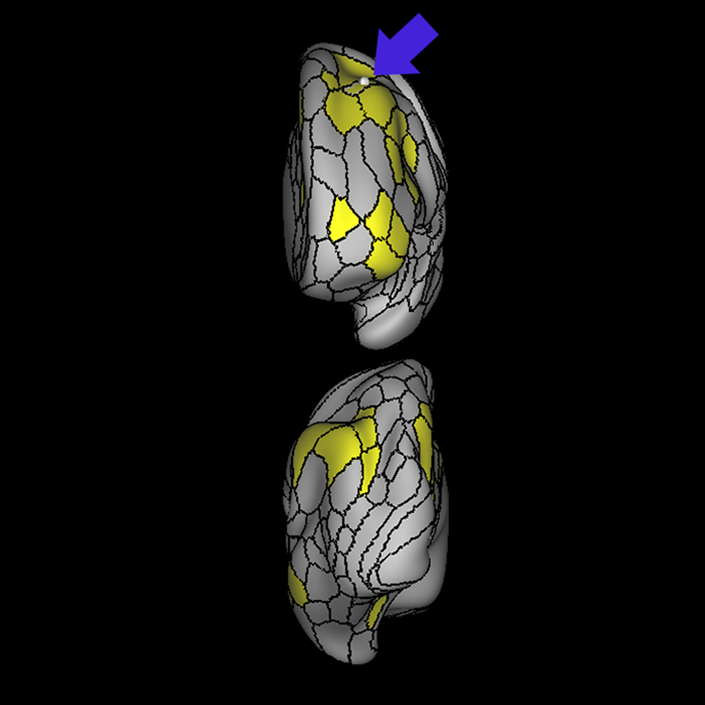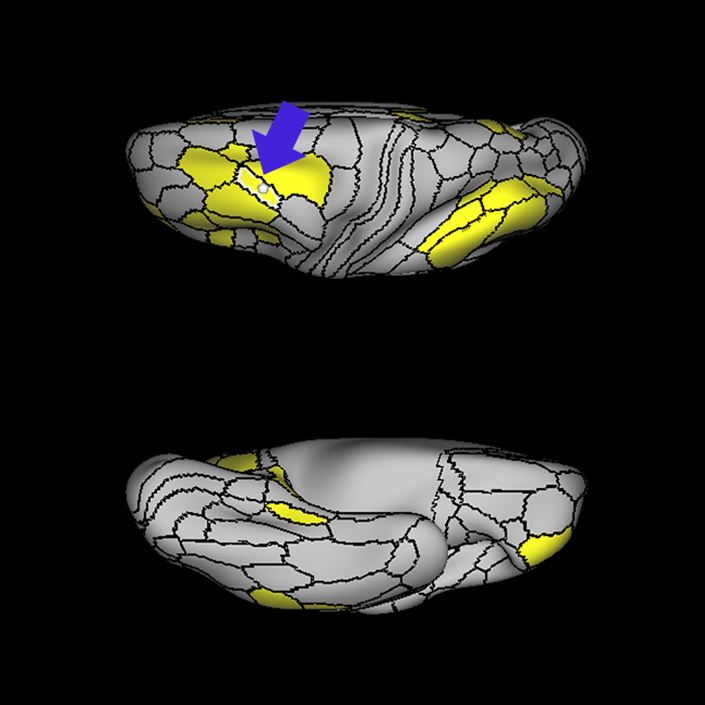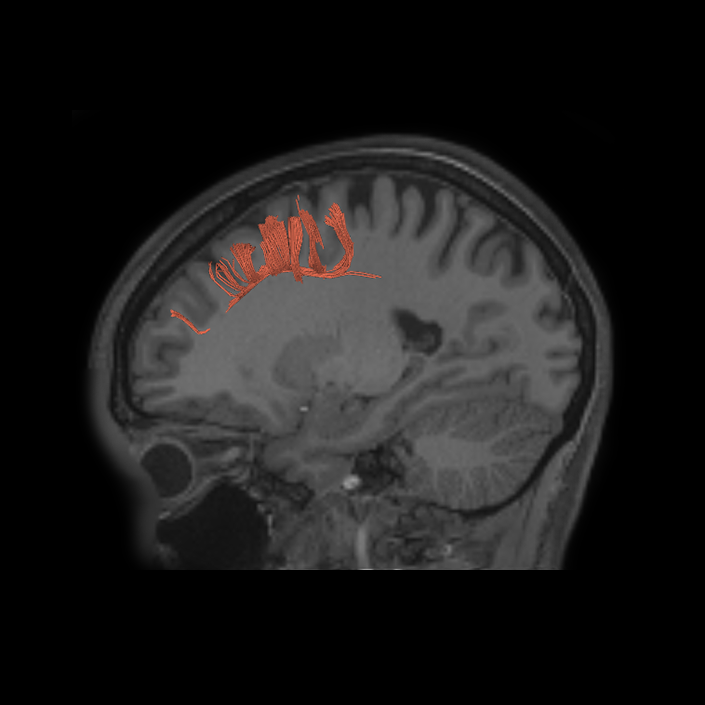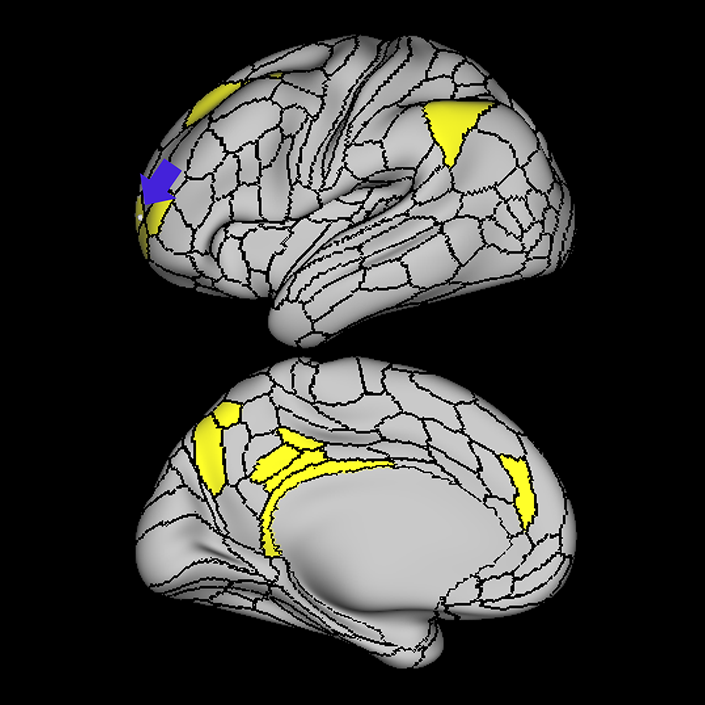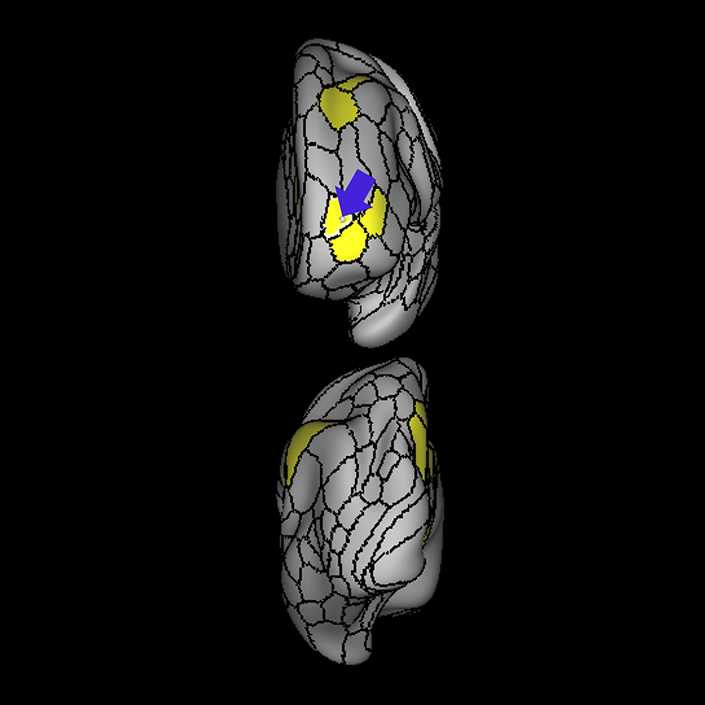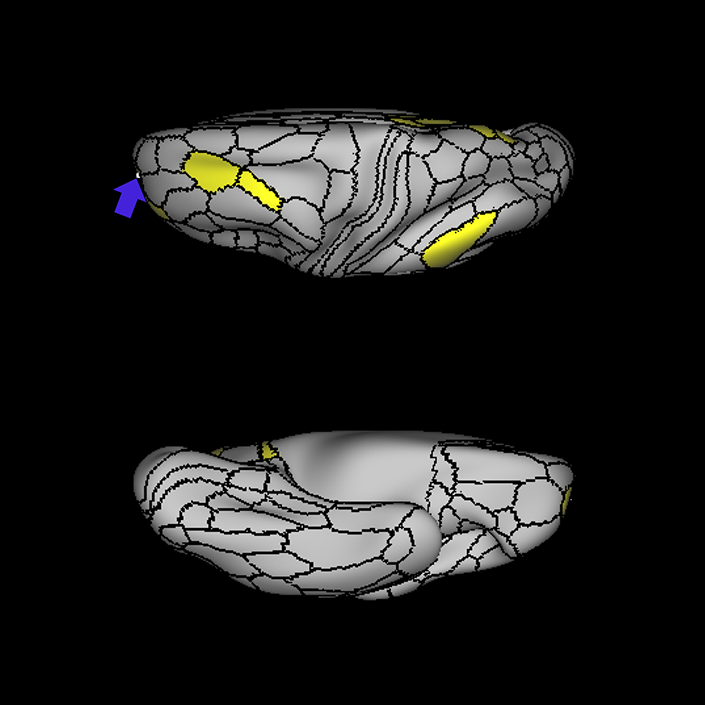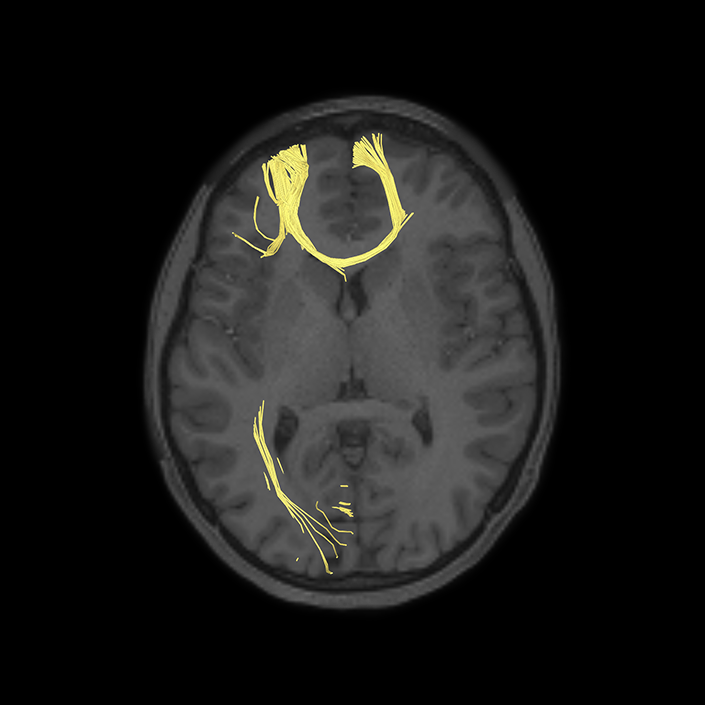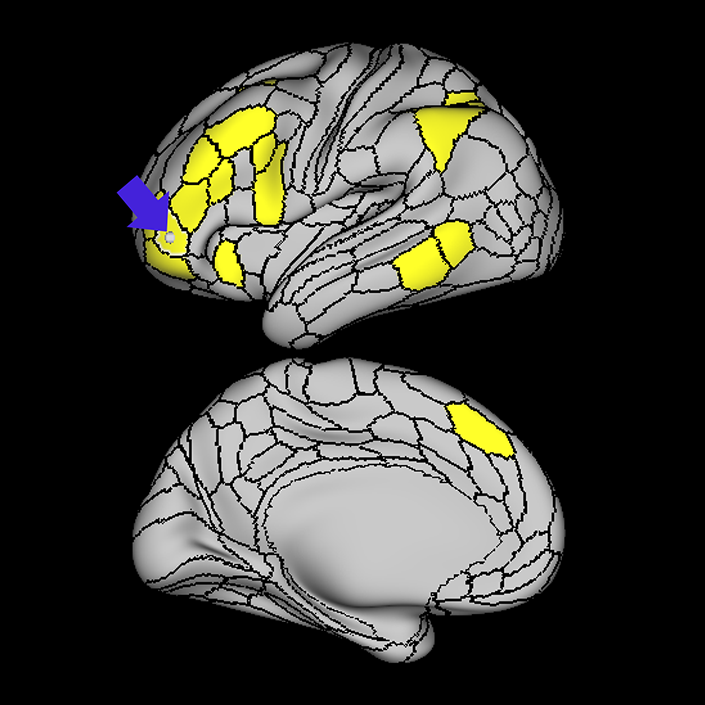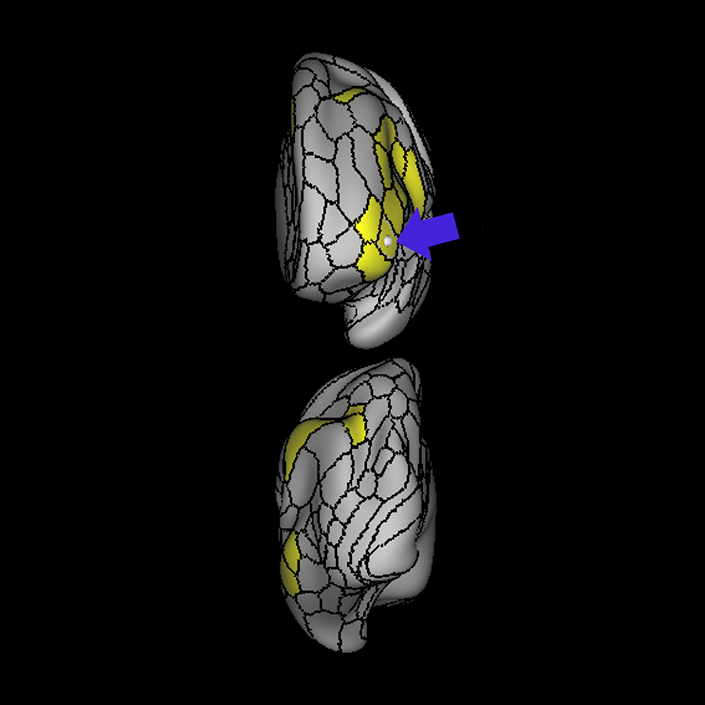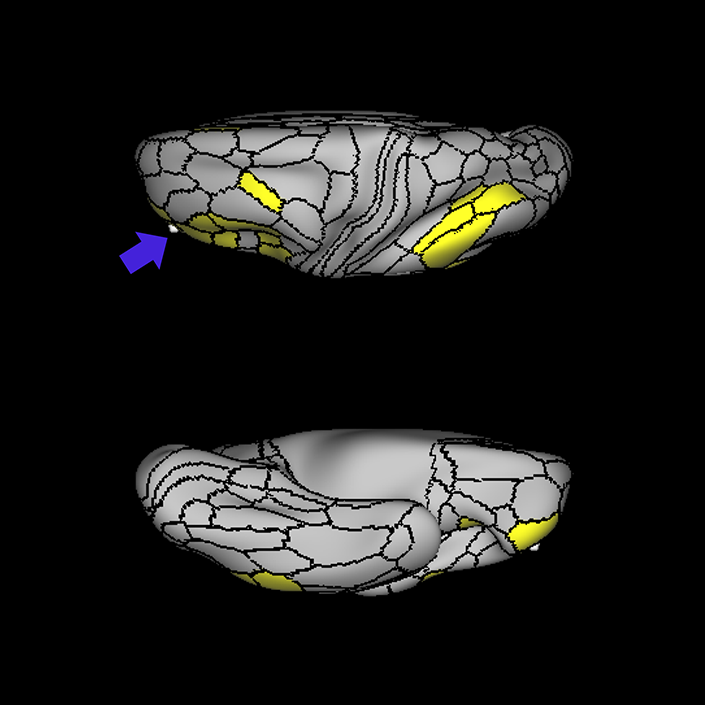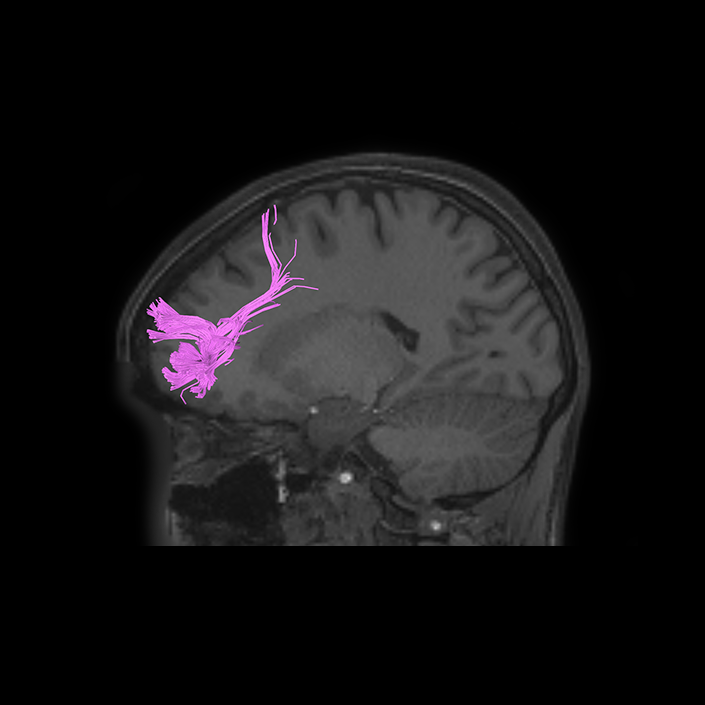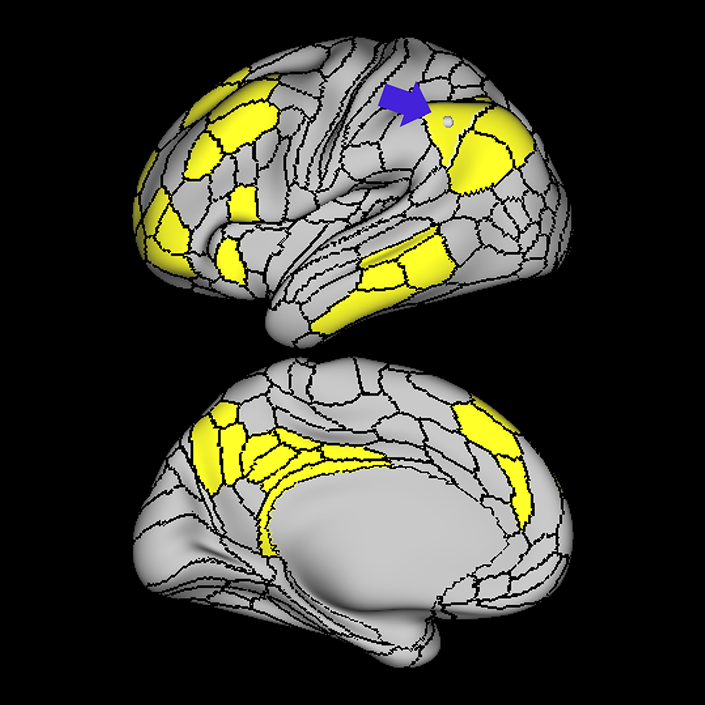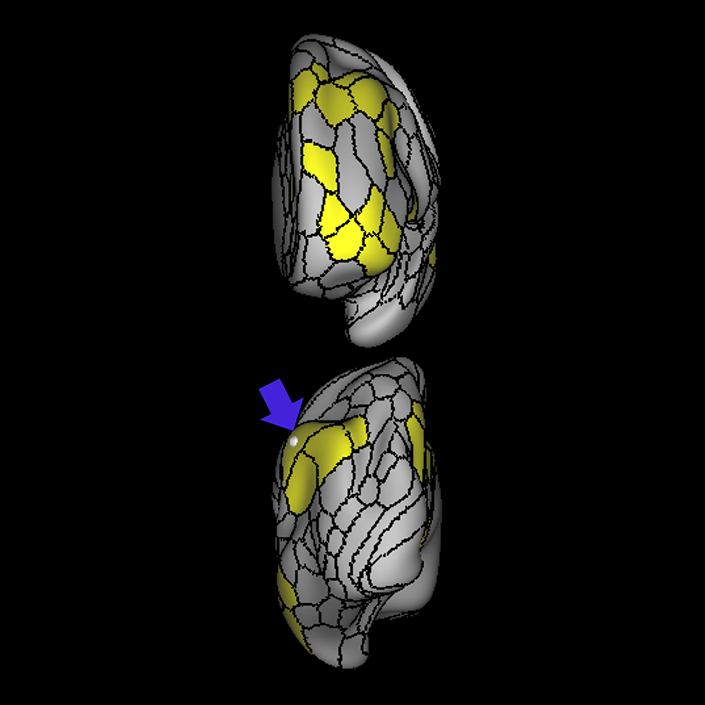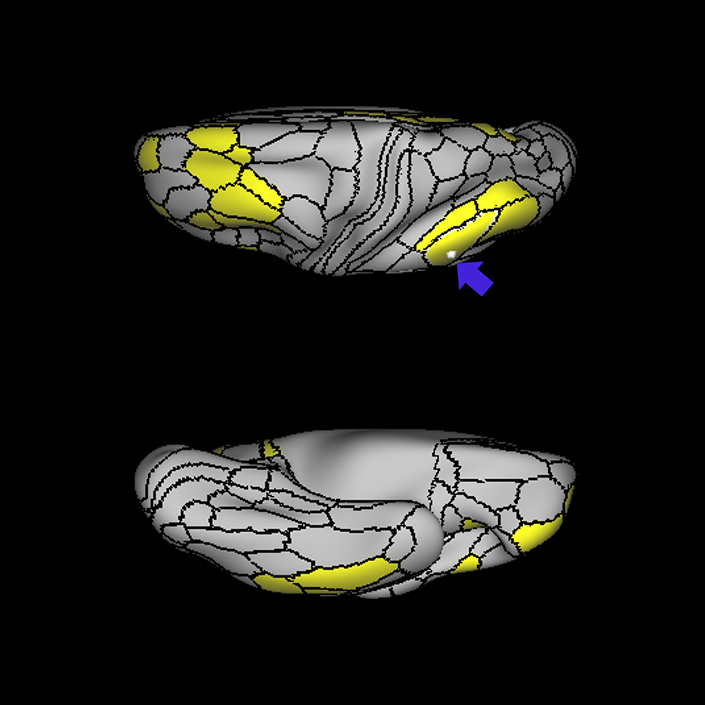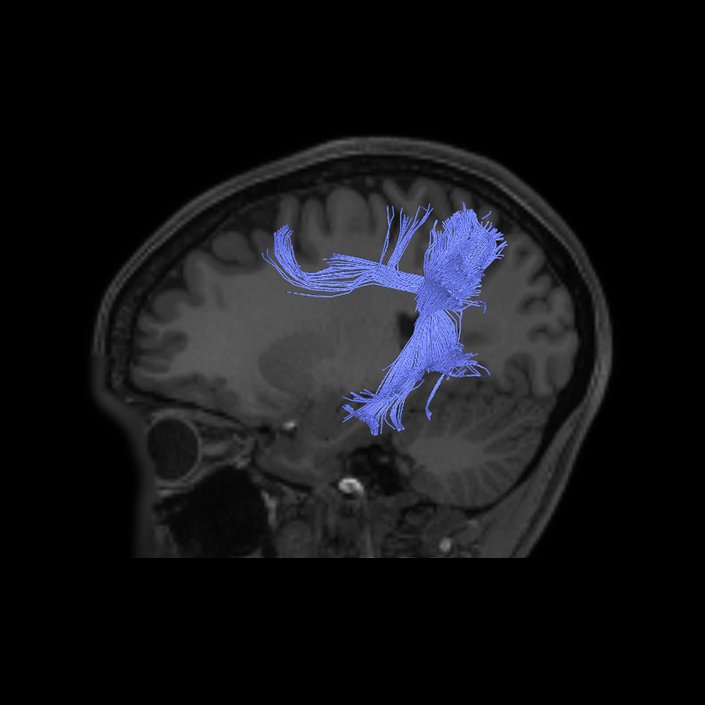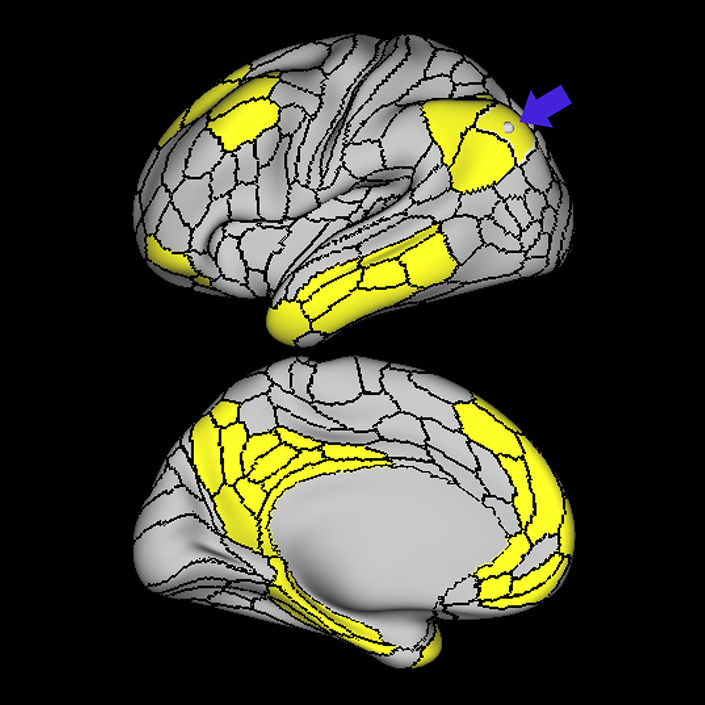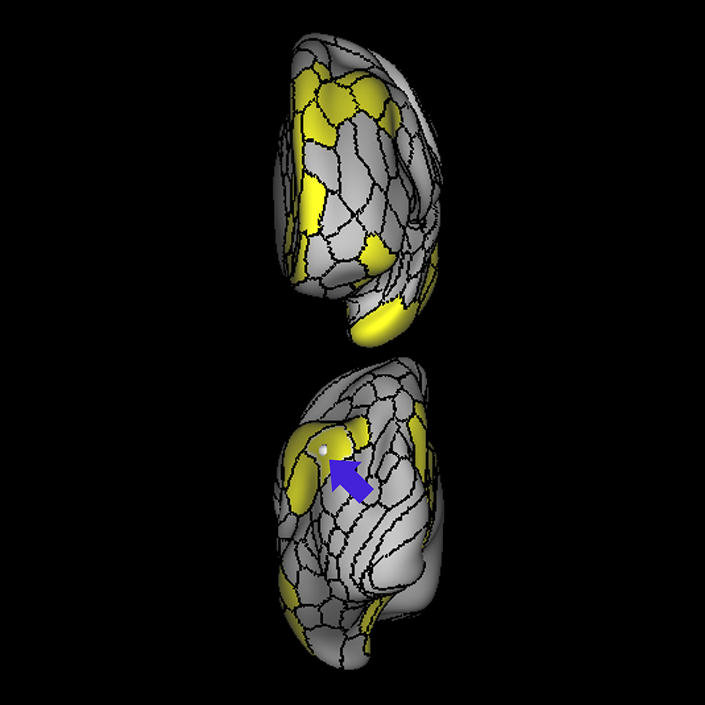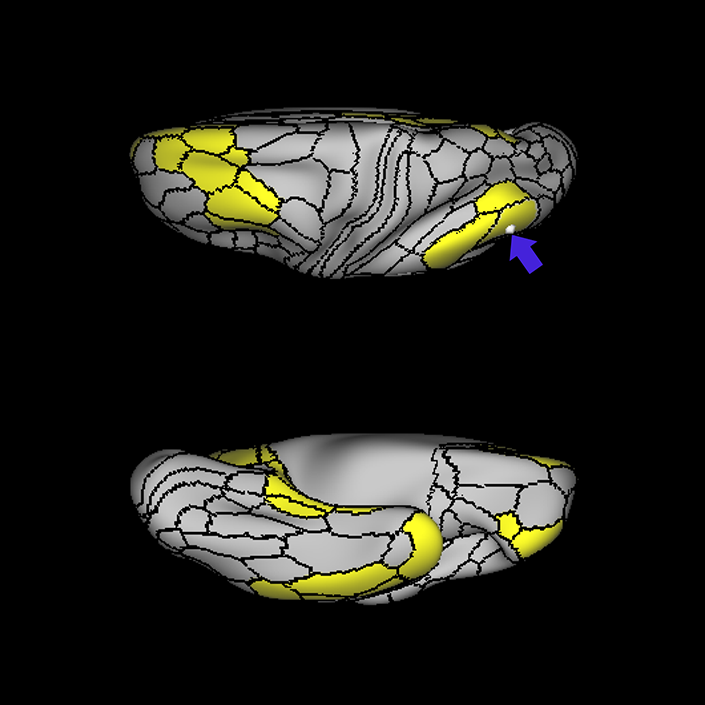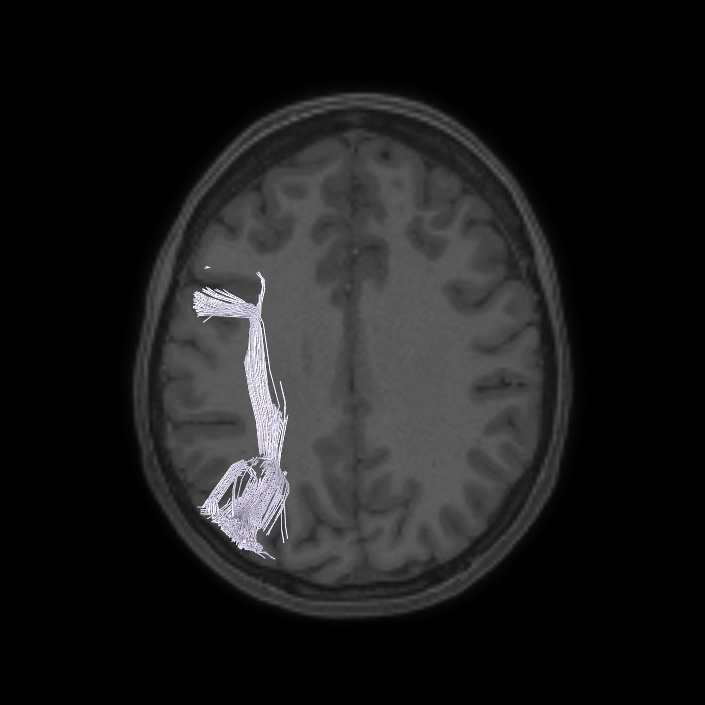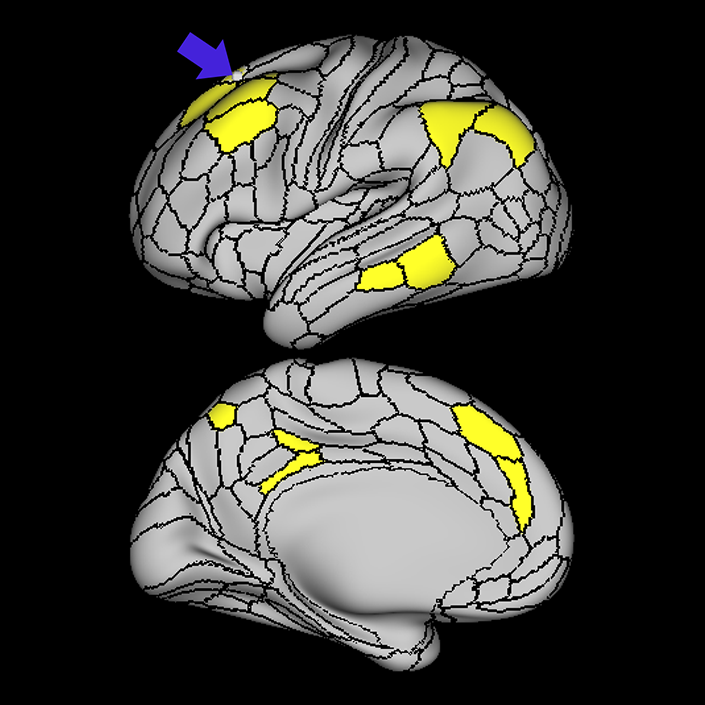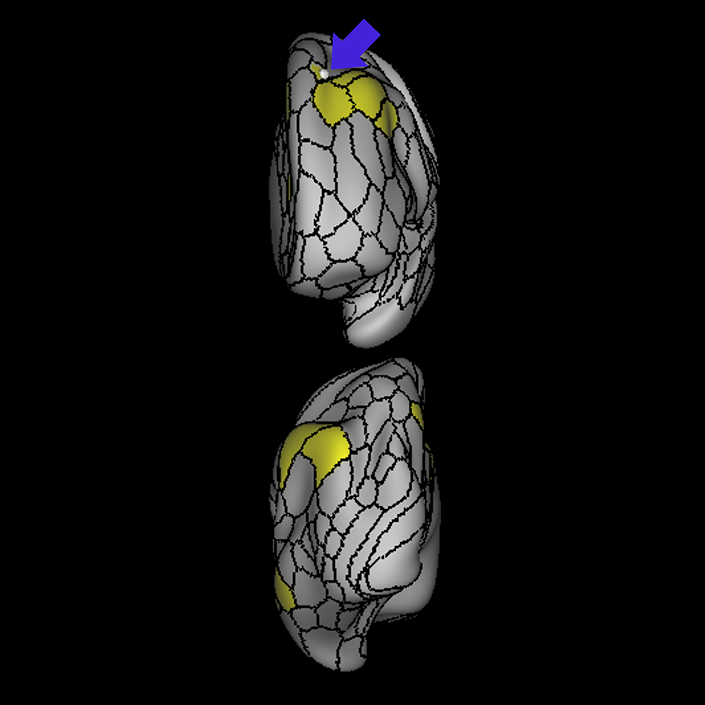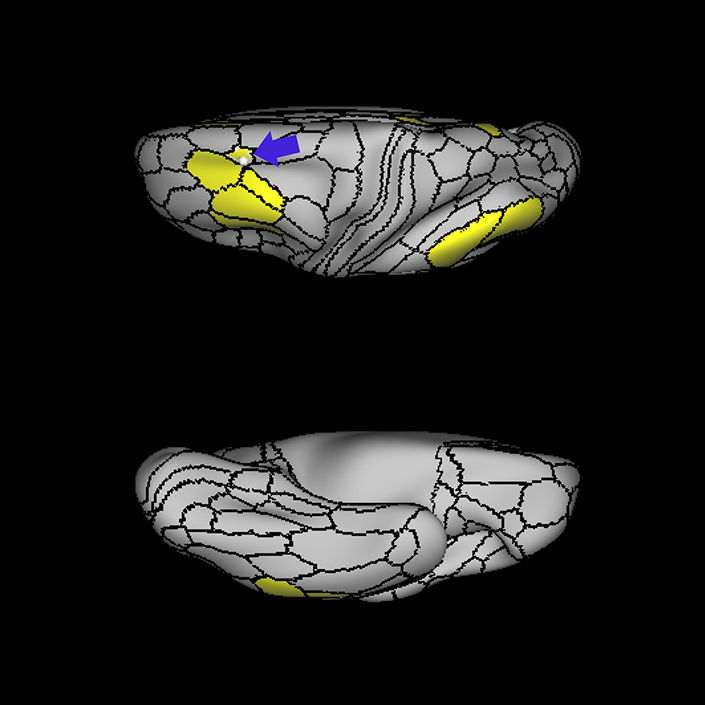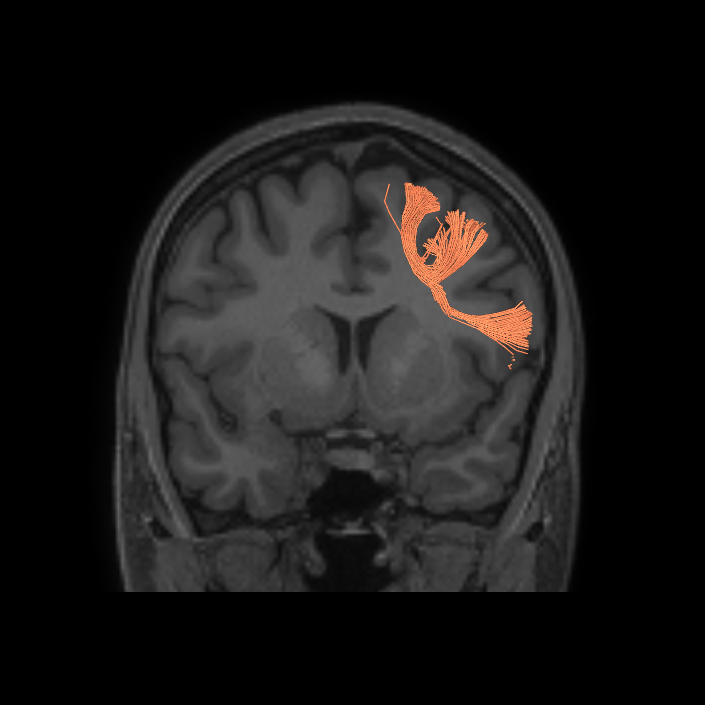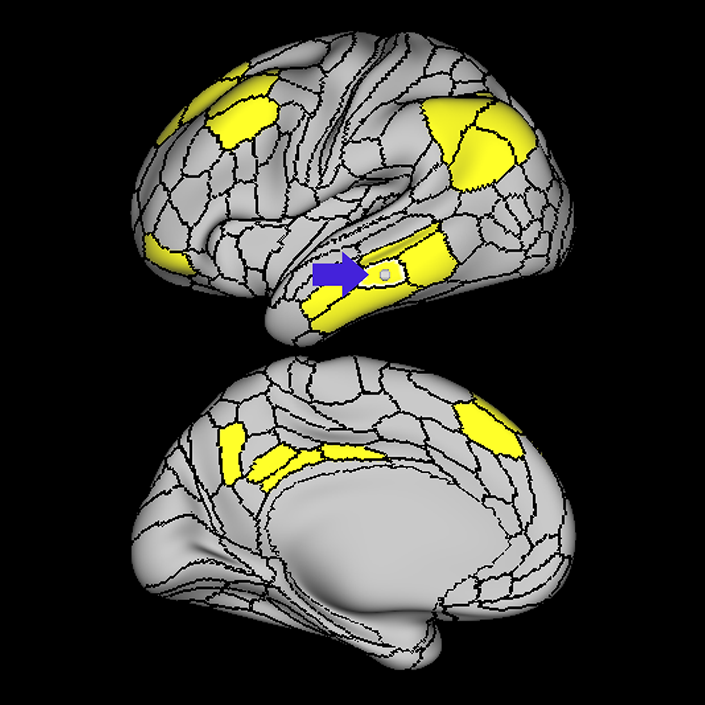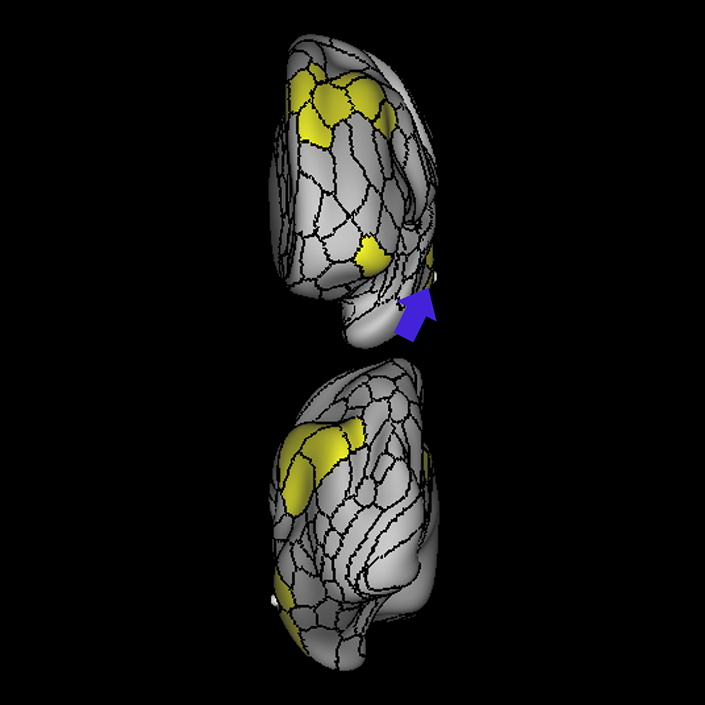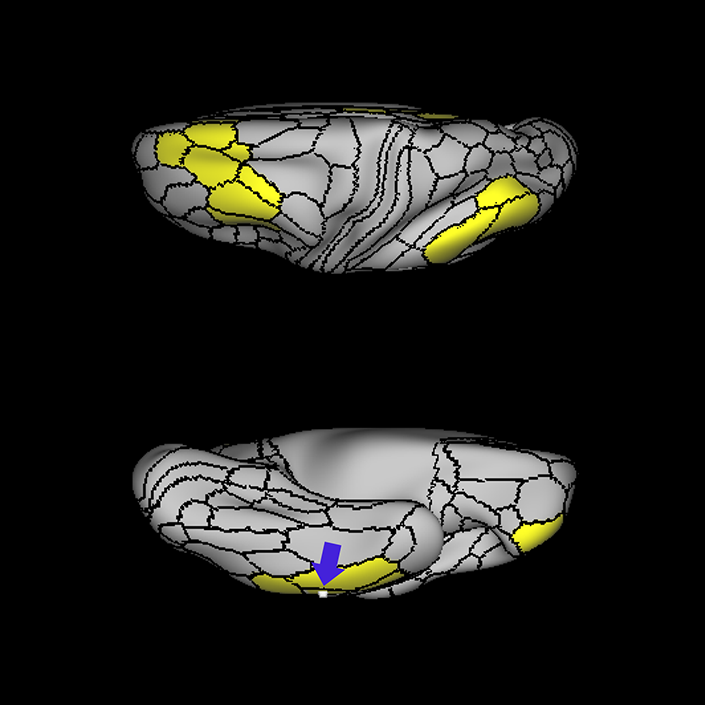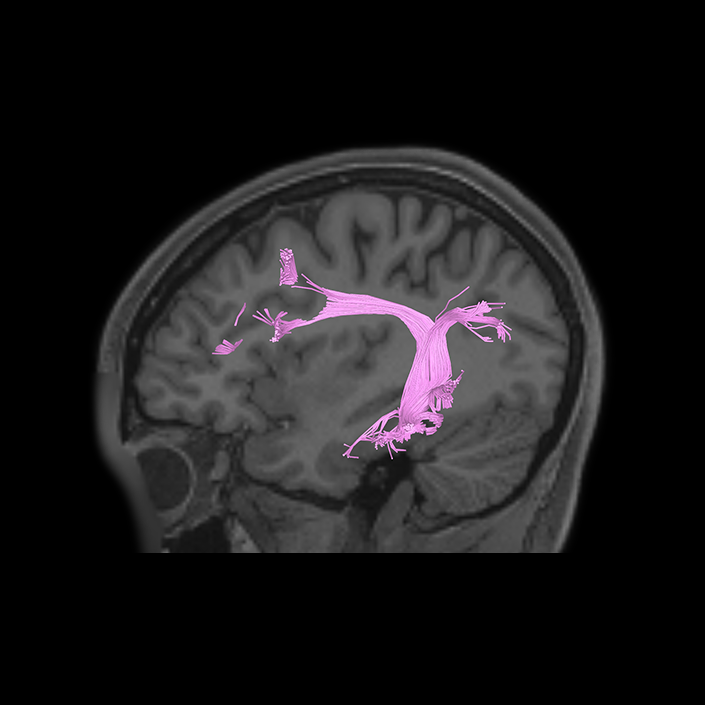ᐅ SummaryArea 8Av (8A ventral): part of the lateral frontal lobe regions. Within the context of spatial working memory, area 8AV is involved in the interpretation of complex visual information and attention. Areas 8 and rostral 6, as part of the posterior dorsolateral frontal areas, are also involved in the maintenance of spatial information. ᐅ Where is it?Area 8AV (8A ventral) is located at the posterior part of the middle frontal gyrus. It is an anterior-to-posterior band which is medial to area 8C. ᐅ What are its borders?Area 8AV borders area 46 anteriorly, and area 55b and the FEF (frontal eye field) posteriorly, as well as i6-8. Its medial border is area 8AD. Its lateral border is area 8C. There is a small anterior border with area 46. ᐅ What are its functional connections?Area 8AV demonstrates functional connectivity to areas 9a, 9p, 9m, 8BL, 8AD, and 8C, i6-8 and s6-8 in the dorsolateral frontal lobe, areas 8BM, SFL, 10d, and d32 in the medial frontal lobe, areas 44 45, A47r 47l and 47s in the inferior frontal lobe, area 55b in the premotor region areas TGd, TE1a, TE1m, TE1p, TE2a, STSva, and STSvp in the temporal lobe, areas PFm, IP1, PGi and PGs in the inferior parietal lobe, and areas 7m, 31pd, 31pv, 31a, 23d, d23ab and v23ab in the medial parietal lobe. ᐅ What are its white matter connections?Area 8AV is structurally connected to the arcuate/SLF and the contralateral hemisphere. Connections to the contralateral hemisphere travel through the body of the corpus callosum to connect to SFL. Connections with the arcuate/SLF project posteriorly and wrap around the sylvian fissure to the parietal lobule to end at 6a, 7PC, MIP, PFm and 2. Local short association bundles are connected with 8C, 8Ad, i6-8 and 46. ᐅ What is known about its function?Within the context of spatial working memory, area 8AV is involved in the interpretation of complex visual information and attention. Areas 8 and rostral 6, as part of the posterior dorsolateral frontal areas, are also involved in the maintenance of spatial information. |
|
A: lateral-medial
B: anterior-posterior
C: superior-inferior
DTI image |
Connectome Guide
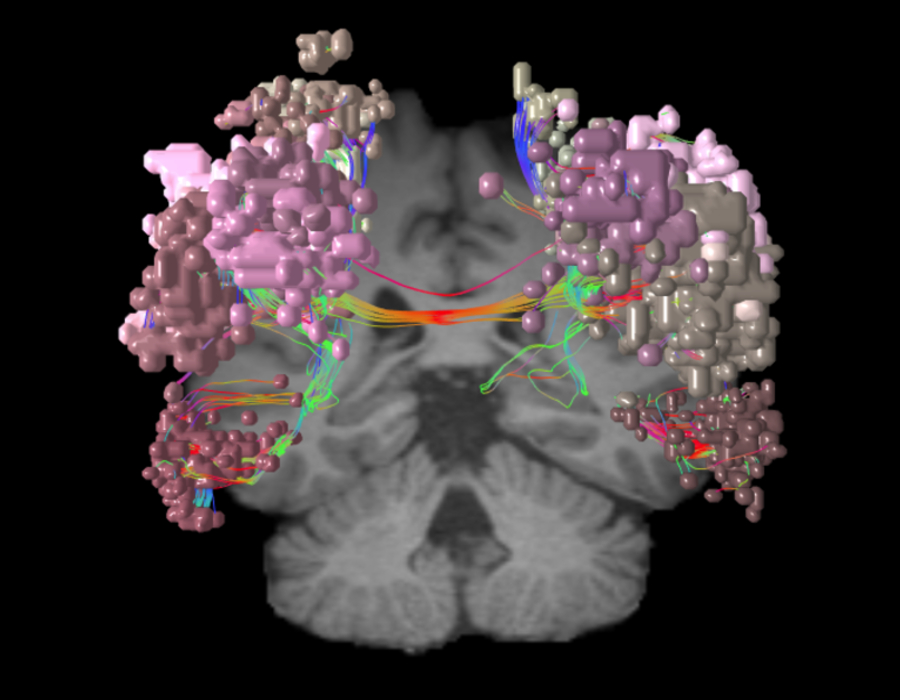
Central Executive Network (CEN)
Why we think this network is worth considering in decision making:
The CEN is one of the most central cognitive networks in the human brain, and dysfunctions of the CEN have been linked to the pathophysiology of numerous neurological and cognitive disorders.
Evidence that this network is responsible for useful function in humans:
CEN encompasses dorsolateral prefrontal cortex and (DLPFC) and posterior parietal cortex (PPC) and reported to be involved in decision making and judgement of goal-directed behavior.1 It has been shown that there is a causal relationship between the activity of CEN and DMN such that activation in the regions of CEN (namely DLPFC) inhibits activation in the components of DMN (namely medial prefrontal cortex).2
Consequences of damage to this network:
CEN deficits have been widely reported in major psychiatric and neurological disorders3including depression, schizophrenia,4 AD, autism, MCI, PTSD and frontotemporal dementia.3,5,6 In patients with schizophrenia, abnormal CEN connectivity patterns related to hallucinations severity.7 In the PTSD, the decreased connectivity profile in the components of CEN was associated with clinical severity.6 In glioma patients, CEN connectivity alterations were found, and these changes were shown to be correlated with working memory.7 Abnormal connectivity in CEN is also reported in chronic migraine patients.8 Several studies associated age related functional connectivity alterations in the CEN with age related task performance decline.9 Comparing functional and structural brain profiles, WMH burden, AD pathology to baseline and longitudinal executive function, Brown et al., (2019) found that executive function was best predicted by CEN activation and DMN deactivation magnitudes in older population.10 Miller et al., (2018) proposed CEN as a “neurobiological moderator” for balancing neighborhood violence and cardiometabolic risk in urban youth, and suggested this network as a neurobiological contributor to resilience.11
ᐅ SummaryArea 8C: part of the lateral frontal lobe regions. Within the context of spatial working memory, area 8C is involved in the interpretation of complex visual information and attention. Areas 8 and rostral 6, as part of the posterior dorsolateral frontal areas, are also involved in the maintenance of spatial information. ᐅ Where is it?Area 8C is located at the posterior part of the middle frontal gyrus. It is an anterior- to-posterior band which is lateral to area 8AV. ᐅ What are its borders?Area 8C has area 8AV as its main medial border. Its lateral border is with 3 inferior frontal sulcus areas: IFSp, IFJa, and IFJp. Area 55b and PEF (precentral eyefield) are its posterior borders (and discussed in a different section). Area p9-46v and to a lesser extent area 46 are its anterior neighbors. ᐅ What are its functional connections?Area 8C demonstrates functional connectivity to areas s6-8, i6-8, a9-46v, p9-46v, a10p, 8BL, 8AD, and 8AV in the dorsolateral frontal lobe, areas 8BM and d32 in the medial frontal lobe, areas IFSp, IFJp, a47r, p47r, and 44 in the inferior frontal lobe, area AVI in the insula, areas TE1m, TE1p, TE2a, STSva, and STSvp in the temporal lobe, areas IP1, IP2, LIPd, PFm, PGi and PGs in the inferior parietal lobe, and areas 7pm, 31pv, 31a, POS2, 23d, and d23ab in the medial parietal lobe. ᐅ What are its white matter connections?Area 8C is structurally connected to the arcuate/SLF and the contralateral hemisphere. Contralateral connections travel through the corpus callosum to end at 8C. Connections with the arcuate/SLF project posteriorly and wrap around the sylvian fissure to the posterior temporal lobe to end at PH and PHT. ᐅ What is known about its function?Within the context of spatial working memory, area 8C is involved in the interpretation of complex visual information and attention. Areas 8 and rostral 6, as part of the posterior dorsolateral frontal areas, are also involved in the maintenance of spatial information. |
|
A: lateral-medial
B: anterior-posterior
C: superior-inferior
DTI image |
ᐅ SummaryArea a10p (anterior 10 polar): part of the lateral frontal lobe regions. involved in episodic and working memory tasks. Brodmann area 10 more generally is activated in relation to increasing complexity of working memory tasks. This area also plays a role in abstract cognitive function. ᐅ Where is it?Area a10p (anterior 10 polar) is located at the fusiform junction of the anterior most aspects of the superior and middle frontal gyri. ᐅ What are its borders?Area a10p borders area 11r on its inferior (orbitofrontal) boundary, and area p10p on its superior boundary. Areas a47r and p47r are its lateral neighbors, and area 10pp is its medial neighbor. ᐅ What are its functional connections?Area a10p demonstrates functional connectivity to areas p10p, a9-46v, 8BM and 8C in the dorsolateral frontal lobe, d32 in the anterior cingulate region, area PFm in the lateral parietal lobe, and POS2 and 7pm in the medial parietal lobe. ᐅ What are its white matter connections?Area a10p is structurally connected to the IFOF and contralateral hemisphere. Contralateral connections travel through the genu of the corpus callosum with the forceps minor to end at 9a and p10p. IFOF connections travel from a10p through the extreme/external capsule and continue posteriorly to end at occipital lobe parcellations V1, V2, V3, V6 and V6a. Local short association bundles are connected to 10d, 10pp, p10p, a9-46v and 9-46d. ᐅ What is known about its function?Area a10p is involved in episodic and working memory tasks. Brodmann area 10 more generally is activated in relation to increasing complexity of working memory tasks. This area also plays a role in abstract cognitive function. |
|
A: lateral-medial
B: anterior-posterior
C: superior-inferior
DTI image |
ᐅ SummaryArea a47r (anterior 47 rostral): part of the lateral frontal lobe regions. Previous research has shown that the pars orbitalis is involved in controlled semantic retrieval. ᐅ Where is it?Area a47r (anterior 47 rostral) is a j-shaped area located at the anterior inferior portion of the pars orbitalis of the inferior frontal gyrus. It has a slight superior bend near its anterior extreme which blends into the anterior middle frontal gyrus. ᐅ What are its borders?Area a47r borders area p47r and area a9-46v; its superior end lies between their anterior surfaces. Its medial neighbor is area a10p. Its posterior edge is with 47l, and it borders 11r on its orbitofrontal side. ᐅ What are its functional connections?Area a47r demonstrates functional connectivity to areasp47r, 8C, 8av 8BL, 8BM, i6-8, a9-46v and p9-46v in the dorsolateral frontal lobe, areas IFSa, IFSp, 47l and 45 in the inferior frontal gyrus regions, areas IP1, IP2, PGi, PGs, and PFm in the inferior parietal lobule, areas TE1m, TE1p, TE2a, and STSv in the lateral temporal lobe, and area d23ab in the posterior cingulate region. ᐅ What are its white matter connections?Area a47r is structurally connected to the IFOF. IFOF connections travel from a47r through the extreme/external capsule and continue posteriorly to end at occipital lobe parcellations V1, V2, V3, V3a, V6, V6a, 7Am and 7PL. Local short association bundles are connected with 47m and 11l. ᐅ What is known about its function?Previous research has shown that the pars orbitalis is involved in controlled semantic retrieval. |
|
A: lateral-medial
B: anterior-posterior
C: superior-inferior
DTI image |
ᐅ SummaryArea a9-46v (anterior 9-46 ventral): part of the lateral frontal lobe regions. Like Area 46, plays a role in goal-directed higher- order cognitive processes. The mid- DLPFC, which includes areas 9-46 and 46, is also involved in the conscious, active control of planned behavior. ᐅ Where is it?Area a9-46v (anterior 9-46 ventral) is located at the anterior portior of the middle frontal gyrus. ᐅ What are its borders?Area a9-46v borders area 46 posteriorly, and area 9-46d medially. Its lateral border is mainly with area p47r and a slight contribution with IFSa. Its anterior limit forms a wedge with areas p10p and a47r. ᐅ What are its functional connections?Area a9-46v demonstrates functional connectivity to area 46, 9-46d, p9-46v, a10p, p10p, 6ma, i6-8, a47r, p47r, 8C, and IFSa in the dorsolateral frontal lobe, areas 8BM, and a32prime in the medial frontal lobe, area 11L in the orbitofrontal region, area TE1p in the temporal lobe, area AVI in the insula, areas LIPd, PF, IP1, and IP2 in the parietal lobe, and areas 7pm, 31a, and RSC in the medial parietal lobe . ᐅ What are its white matter connections?Area a9-46v is structurally connected to local parcellations. White matter tracts from this parcellation are highly variable. Short association bundles connect with 8C, 9-46d, 46, IFSa and p47r. ᐅ What is known about its function?Area 9-46d, like Area 46, plays a role in goal-directed higher-order cognitive processes. The mid-dorsolateral prefrontal cortex, which includes areas 9-46 and 46, is also involved in the conscious, active control of planned behavior. |
|
A: lateral-medial
B: anterior-posterior
C: superior-inferior
DTI image |
ᐅ SummaryArea i6-8 (inferior 6-8): part of the lateral frontal lobe. Areas s6-8 and i6-8 represent transitional areas of cortex between Brodmann areas 6 and 8. Areas 8 and rostral 6, as part of the posterior dorsolateral frontal areas, are involved in the maintenance of spatial information. Brodmann area 6 has also been subdivided into areas including the premotor and supplementary motor areas that influence motor control. The premotor area, which encompasses the lateral part of area 6, is further divided into ventral and dorsal portions, named PMv and PMd, respectively. ᐅ Where is it?Area i6-8 (inferior 6-8) is located at the posterior medial MFG near where the SFS joins with the precentral sulcus. ᐅ What are its borders?Area i6-8 borders area 6a medially, and area 55b and FEF laterally. Area 8AV is its lateral border. ᐅ What are its functional connections?Area i6-8 demonstrates functional connectivity to areas s6-8, a9-46v, p9-46v, p10p, 8C, 8AD, and 8AV in the dorsolateral frontal lobe, areas 8BM and d32 in the medial frontal lobe, areas IFSp, IFJp, a47r, p47r, and 44 in the inferior frontal lobe, area 6a in the premotor region, areas TE1m, TE1p, TE2a, PHA2, and PreS the temporal lobe, areas IP0, IP1, IP2, LIPd, PFm, and PGs in the inferior parietal lobe, and areas 7pm, 7m, 31a, POS2, POS1, and d23ab in the medial parietal lob. ᐅ What are its white matter connections?Area i6-8 is structurally connected to surrounding parcellations. White matter tracts from this parcellation are variable. Local short association bundles connect with 8Av, 8Ad, 9-46d, 6a and FEF. ᐅ What is known about its function?Areas s6-8 and i6-8 represent transitional areas of cortex between Brodmann Areas 6 and 8, previously described by Economo and Koskinas. Areas 8 and rostral 6, as part of the posterior dorsolateral frontal areas, are involved in the maintenance of spatial information. Brodmann Area 6 has also been subdivided into areas including the premotor and supplementary motor areas that influence motor control. The premotor area, which encompasses the lateral part of area 6, is further divided into ventral and dorsal portions, named PMv and PMd, respectively. |
|
A: lateral-medial
B: anterior-posterior
C: superior-inferior
DTI image |
ᐅ SummaryArea p10p (posterior 10 polar): part of the lateral frontal lobe regions. Involved in episodic and working memory tasks. Brodmann area 10 more generally is activated in relation to increasing complexity of working memory tasks. This area also plays a role in abstract cognitive function. ᐅ Where is it?Area p10p (posterior 10 polar) is located on the lateral bank of the anterior aspect of the superior frontal gyrus, just posterior to a10p. It straddles the anterior most point of the superior frontal sulcus which terminates here. ᐅ What are its borders?Area p10p borders area a10p on its anterior boundary, and area a9-46d and a small part of area 9a on its superior boundary. Area 9-46d is also its lateral neighbor. It is slightly triangular shaped and its superior apex is wedged between area 9a and area 9-46d. ᐅ What are its functional connections?Area p10p demonstrates functional connectivity to a10p and a9-46v in the anterior frontal lobe, d32 in the anterior cingulate region, i6-8 in the posterior frontal lobe, areas 31a, 31pv, d23ab, POS2, RSC, and 7pm in the posterior cingulate region, and area PFm in the inferior parietal lobule. ᐅ What are its white matter connections?Area p10p is structurally connected to the IFOF and contralateral hemisphere. Contralateral connections travel through the genu of the corpus callosum with forceps minor to end at 9m. IFOF connections travel from p10p through the extreme/external capsule and continue posteriorly to end at occipital lobe parcellations V1 and V2. Local short association bundles are connected with 9-46d, 10d, a10p, a9-46v and p9-46v. ᐅ What is known about its function?Area p10p is involved in episodic and working memory tasks. Brodmann area 10 more generally is activated in relation to increasing complexity of working memory tasks. This area also plays a role in abstract cognitive function. |
|
A: lateral-medial
B: anterior-posterior
C: superior-inferior
DTI image |
ᐅ SummaryArea p47r (posterior 47 rostral): part of the lateral frontal lobe regions. Brodmann area 47 is activated during the processing of linguistically complex words. In the recognition of spoken language, Brodmann area 47 increases in activity as the cohort of spoken words increases in size. ᐅ Where is it?Area p47r (posterior 47 rostral) is located at the anterior end of the inferior frontal sulcus in the antero-superior most part of the inferior frontal gyrus. ᐅ What are its borders?Area p47r borders area a47r anteriorly and IFSa posteriorly. Its entire medial border is with area a9-46v. It has a small lateral border with area 45 ᐅ What are its functional connections?Area p47r demonstrates functional connectivity to areas a47r, a9-46v, p9-46v, 8BM, 8C, and i6-8 in the dorsolateral frontal lobe, areas IFSa, IFSp, IFJp, and 6r in the inferior frontal lobe, area AVI in in the insula, areas TE1p and PHT in the temporal lobe, area PFm in the inferior parietal lobe, and areas IP2, IP1, and LIPd in the intraparietal a. ᐅ What are its white matter connections?Area p47r is structurally connected with surrounding parcellations. The white matter tracts from this parcellation are highly inconsistent. Some individuals seem to have connections with the IFOF. Local short association bundles are connected to a47r, p10p, 45, IFSa, s6-8, 9-47d and 9a. ᐅ What is known about its function?Brodmann Area 47 is activated during the processing of linguistically complex words. In the recognition of spoken language, Brodmann area 47 increases in activity as the cohort of spoken words increases in size. |
|
A: lateral-medial
B: anterior-posterior
C: superior-inferior
DTI image |
ᐅ SummaryArea PFm (parietal area F, part m): part of the lateral parietal lobe regions. Shows activation in nonspatial attention tasks, decision making when switching choices, rule change during visually guided attention, and reorientation. Also provide syntactical components to language processing, plays a role in attentional processing, and is activated in working memory, motor cue, and risk-related tasks. ᐅ Where is it?Area PFm (parietal area F, part m) is found on the anterior superior surface of the angular gyrus, and straddles the sulcus to lie on the posterior superior bank of the supramarginal gyrus. ᐅ What are its borders?Area PFm borders IP2 and IP1 superiorly, PF anteriorly, PSL and STV inferiorly, and PGI and PGS posteriorly. ᐅ What are its functional connections?Area PFm demonstrates functional connectivity to areas 8AV, 8AD, 8BL, 8C, s6-8, i6-8, a47r, p47r, a10p, p10p, 9a, a9-46v, p9-46v, and area 44 in the lateral frontal lobe, area d32 in the medial frontal lobe, area AVI in the insula, areas STSvp, TE1m, TE1p, and TE2a, in the temporal lobe, areas PGs, PGi, IP2, and IP1 in the lateral parietal lobe, and areas 7m, 7pm, POS2, 31a, 31pv, d23ab, 23d and RSC in the medial parietal lobe. ᐅ What are its white matter connections?Area PFm is structurally connected to the arcuate/SLF. Arcuate/SLF connections course anteriorly from PFm to 8C and 8BM, and inferiorly to middle temporal gyrus parcellations TE1a, TE1m, TE1p, STSva, STSvp and PHT. Local short association bundles connect with AIP, 7PC, IP1, IP2, LIPd, LIPv, PGi, PGs, 2 and 1 ᐅ What is known about its function?PFm shows activation in non-spatial attention tasks, decision making when switching choices, rule change during visually-guided attention, and reorientation. Intermediate regions of the inferior parietal lobule also provide syntactical components to language processing. This area also plays a role in attentional processing, and is activated in working memory, motor cue, and risk-related tasks. |
|
A: lateral-medial
B: anterior-posterior
C: superior-inferior
DTI image |
ᐅ SummaryArea PGs (parietal area G superior): part of the lateral parietal lobe regions. Shows activity when individuals change their visuospatial attention from one area to another. Specifically, it is involved in the response to biological motion. It is a major node in the task-negative network, which mostly functions to redirect attention towards relevant stimuli. Also relevant in number processing. ᐅ Where is it?Area PGs (parietal area G superior) is found on the superior surface of the angular gyrus. ᐅ What are its borders?Area PGs borders PFm anteriorly, PGi inferiorly, PGp posteriorly and IP1 and IP0 superiorly. ᐅ What are its functional connections?Area PGs demonstrates functional connectivity to areas 8AD, 8AV, 8BL, 8C, s6-8, i6-8, a47r, 47m, 10d, and 9p in the lateral frontal lobe, areas 9m, 10v, 10r, 8BM, a24, d32, and s32 in the medial frontal lobe, areas PHA1, PHA2, PreS, EC, the hippocampus, STSva, STSvp, TGd, TE1a, TE1m, TE1p, and TE2a, in the temporal lobe, areas PFm, PGi, and IP1 in the lateral parietal lobe, and areas 7m, 7pm, POS1, POS2, 31a, 31pd, 31pv, d23ab, v23ab, 23d and RSC in the medial parietal lobe. ᐅ What are its white matter connections?Area PGs is structurally connected to the arucate/SLF. Arcuate/SLF connections course anteriorly from PGs to inferior frontal sulcus parcellations IFJa, IFJp and IFSp, and inferiorly to occipitotemporal junction areas PHT, FST and TPOJ2. Local short association bundles connect with PFm, PGi, PGp, IP0, IP1, IP2 and MIP. ᐅ What is known about its function?Area PGs shows activity when individuals change their visuospatial attention from one area to another. Specifically, PGs is involved in the response to biological motion. It is a major node in the task-negative network, which mostly functions to re-direct attention toward relevant stimuli. This region is also relevant in number processing. Area PGs is superior to area PGi, but these regions are not differentiated well within the literature. |
|
A: lateral-medial
B: anterior-posterior
C: superior-inferior
DTI image |
ᐅ SummaryArea s6-8 (superior 6-8): part of lateral temporal lobe. Areas s6-8 and i6-8 represent transitional areas of cortex between Brodmann areas 6 and 8. Areas 8 and rostral 6, as part of the posterior dorsolateral frontal areas, are involved in the maintenance of spatial information. Brodmann area 6 has also been subdivided into areas including the premotor and supplementary motor areas that influence motor control. The premotor area, which encompasses the lateral part of area 6, is further divided into ventral and dorsal premotor portions, named PMv and PMd, respectively. ᐅ Where is it?Area s6-8 (superior 6-8) is located at the posterior most superior frontal gyrus, on its lateral bank near where the SFS joins with the precentral sulcus. ᐅ What are its borders?Area s6-8 borders areas 8AD and 8BL anteriorly. Its medial border is SFL (discussed in later sections). Its posterior border is made of areas 6ma and 6a. ᐅ What are its functional connections?Area s6-8 demonstrates functional connectivity to areas i6-8, 8C 8AD, and 8AV in the dorsolateral frontal lobe, areas 8BM and d32 in the medial frontal lobe, areas TE1m andTE1p in the temporal lobe, areas PFm and PGs in the inferior parietal lobe, and areas 7pm, 31a, and d23ab in the medial parietal lobe. ᐅ What are its white matter connections?Area s6-8 is structurally connected to the FAT. Connections from the FAT project to the inferior frontal gyrus to terminate at 44, FOP4 and 6r. Local short association bundles connect to 8. ᐅ What is known about its function?Areas s6-8 and i6-8 represent transitional areas of cortexbetween Brodmann Areas 6 and 8, previously described by Economo and Koskinas. Areas 8 and rostral 6, as part of the posterior dorsolateral frontal areas, are involved in the maintenance of spatial information. Brodmann Area 6 has also been subdivided into areas including the premotor and supplementary motor areas that influence motor control. The premotor area, which encompasses the lateral part of area 6, is further divided into ventral and dorsal premotor portions, named PMv and PMd, respectively. PMv has a significant contribution to the control of object manipulation with the hands, specifically when it comes to the force applied with precision grip. In addition, PMv contains mirror neurons that play a role in understanding actions performed by others. PMd is involved in selecting motor responses based on both arbitrary and spatial cues. For example, the PMd integrates sensory information to guide motor tasks such as reaching for an object. In addition to sensory connections, the PMd also communicates with the prefrontal cortex. Within this subdivision, the caudal portion of the PMd connects to the primary motor area, and the rostral portion analyzes cues to select motor responses. |
|
A: lateral-medial
B: anterior-posterior
C: superior-inferior
DTI image |
ᐅ SummaryArea TE1m (temporal area 1 middle): part of the temporal lobe regions. Appears primarily related to visual pathways. TE1m, like TE1p, shows greater activation in the visual working memory secondary contrast compared to area TE1a. Relative to TE1p, TE1m is less deactivated during language tasks and more deactivated in theory of mind tasks. In fact, TE1m is more deactivated in theory of mind tasks than all of its neighbors. ᐅ Where is it?Area TE1m (TE1 middle) is found on the lateral surface of the middle portion of the MTG. It spills across the corresponding portion of the inferior temporal sulcus and occupiessome of the superior portion of the corresponding portion of the ITG. ᐅ What are its borders?Area TE1m borders TE1a anteriorly and TE1p posteriorly. Its superior border is STSvp and its inferior border is TE2a. ᐅ What are its functional connections?Area TE1m demonstrates functional connectivity to a47r, 8AV 8BL, 8AD, 8C, 9p, 47L, i6-8 and s6-8 in the frontal lobe, areas STSvp, TE2a, TE1p, and TE1a in the temporal lobe, and areas PGs, PFm, IP1, 7m, d23ab, 31pv, and 31pd in the parietal lobe. ᐅ What are its white matter connections?Area TE1m is structurally connected to the arcuate/SLF and "u" fibers of the occipito-temporal system. Arcuate/SLF tracts wrap around the Sylvian fissure projecting toward the frontal lobe to turn medially and end at 44, 45, IFJa, IFJp and 8C. There are posterior projections from the arcuate/SLF that terminate at the inferior parietal lobule at PGi and PFm. Local short association fibers include "u" fibers of the occipito-temrporal system that connect to TE1p and TE1a. ᐅ What is known about its function?The function of area TE1m appears primarily related to visual pathways. TE1m, like TE1p, shows greater activation in the visual working memory secondary contrast compared to area TE1a. Relative to TE1p, TE1m is less deactivated during language tasks and more deactivated in theory of mind tasks. In fact, TE1m is more deactivated in theory of mind tasks than all of its neighbors. |
|
A: lateral-medial
B: anterior-posterior
C: superior-inferior
DTI image |
Reference list
- Koechlin E, Hyafil A. Anterior prefrontal function and the limits of human decision-making. Science, 2007;318(5850), 594–598. https://doi.org/10.1126/science.1142995
- Chen C, Oathes J, Chang C, Bradley T, Zhou W, Williamsa M, Glover H, Deisseroth K., & Etkin, A. Causal interactions between fronto-parietal central executive and default-mode networks in humans. Proceedings of the National Academy of Sciences of the United States of America, 2013;110(49), 19944–19949. https://doi.org/10.1073/pnas.1311772110
- Vinod M. Large-scale brain networks and psychopathology: a unifying triple network model. Trends in Cognitive Sciences Xx, 2011;1–24. https://doi.org/10.1016/j.tics.2011.08.003
- Woodward D, Rogers B, Heckers S. Functional resting-state networks are differentially affected in schizophrenia. Schizophrenia Research, 2011;130(1–3), 86–93. https://doi.org/10.1016/j.schres.2011.03.010
- Chand B, Hajjar I, Qiu D. Disrupted interactions among the hippocampal, dorsal attention, and central‐executive networks in amnestic mild cognitive impairment. Human Brain Mapping, 2018;39(12), 4987–4997. https://doi.org/10.1002/hbm.24339
- Liu Y, Li L, Li B, Feng N, Li L, Zhang X, Lu H, Yin H. Decreased Triple Network Connectivity in Patients with Recent Onset Post-Traumatic Stress Disorder after a Single Prolonged Trauma Exposure. Scientific Reports, 2017;7(1), 1–10. https://doi.org/10.1038/s41598-017-12964-6
- Manoliu A, Riedl V, Zherdin A, Mühlau M, Schwerthöffer D, Scherr M, Peters H, Zimmer C, Förstl H, Bäuml J, Wohlschläger M, Sorg C. Aberrant Dependence of Default Mode/Central Executive Network Interactions on Anterior Insular Salience Network Activity in Schizophrenia. Schizophrenia Bulletin, 2014;40(2), 428–437. https://doi.org/10.1093/schbul/sbt037
- Maesawa S, Bagarinao E, Fujii M, Futamura M, Motomura K, Watanabe H, Mori D, Sobue G, Wakabayashi T. (2015). Evaluation of resting state networks in patients with gliomas: Connectivity changes in the unaffected side and its relation to cognitive function. PLoS ONE, 2015;10(2), 1–13. https://doi.org/10.1371/journal.pone.0118072
- Androulakis M, A Krebs K, G Finkel A, Rorden C, D.Newman- Norlund R, Jenkins C, Maleki N. Central Executive and Default Mode Network Intra-network Functional Connectivity Patterns in Chronic Migraine. Journal of Neurological Disorders, 2018;06(05). https://doi.org/10.4172/2329-6895.1000393
- Brown A, Schmitt A, Smith D, Gold T. Distinct patterns of default mode and executive control network circuitry contribute to present and future executive function in older adults. NeuroImage, 2019;195, 320–332. https://doi.org/10.1016/j.neuroimage.2019.03.073
- Miller E, Chen E, Armstrong C, Carroll L, Ozturk S, Rydland J, Brody H, Parrish B, Nusslock R. 1810067115 PNAS. 2018;115(47), 12063–12068. https://doi.org/10.1073/pnas.1810067115




